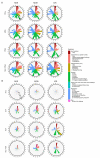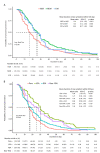Post-COVID symptom profiles and duration in a global convalescent COVID-19 observational cohort: Correlations with demographics, medical history, acute COVID-19 severity and global region
- PMID: 37352144
- PMCID: PMC10289480
- DOI: 10.7189/jogh.13.06020
Post-COVID symptom profiles and duration in a global convalescent COVID-19 observational cohort: Correlations with demographics, medical history, acute COVID-19 severity and global region
Abstract
Background: Post-COVID conditions are characterised by persistent symptoms that negatively impact quality of life after SARS-CoV-2 diagnosis. While post-COVID risk factors and symptoms have been extensively described in localised regions, especially in the global north, post-COVID conditions remain poorly understood globally. The global, observational cohort study HVTN 405/HPTN 1901 characterises the convalescent course of SARS-CoV-2 infection among adults in North and South America and Africa.
Methods: We categorised the cohort by infection severity (asymptomatic, symptomatic, no oxygen requirement (NOR), non-invasive oxygen requirement (NIOR), invasive oxygen requirement (IOR)). We applied a regression model to assess correlations of demographics, co-morbidities, disease severity, and concomitant medications with COVID-19 symptom persistence and duration across global regions.
Results: We enrolled 759 participants from Botswana, Malawi, South Africa, Zambia, Zimbabwe, Peru, and the USA a median of 51 (interquartile range (IQR) = 35-66) days post-diagnosis, from May 2020 to March 2021. 53.8% were female, 69.8% were 18-55 years old (median (md) = 44 years old, IQR = 33-58). Comorbidities included obesity (42.8%), hypertension (24%), diabetes (14%), human immunodeficiency virus (HIV) infection (11.6%) and lung disease (7.5%). 76.2% were symptomatic (NOR = 47.4%; NIOR = 22.9%; IOR = 5.8%). Median COVID-19 duration among symptomatic participants was 20 days (IQR = 11-35); 43.4% reported symptoms after COVID-19 resolution, 33.6% reported symptoms ≥30 days, 9.9% reported symptoms ≥60 days. Symptom duration correlated with disease severity (P < 0.001, NIOR vs NOR; P = 0.003, IOR vs NOR), lung disease (P = 0.001), race (P < 0.05, non-Hispanic Black vs White), and global region (P < 0.001). Prolonged viral shedding correlated with persistent abdominal pain (odds ratio (OR) = 5.51, P < 0.05) and persistent diarrhoea (OR = 6.64, P < 0.01).
Conclusions: Post-COVID duration varied with infection severity, race, lung disease, and region. Better understanding post-COVID conditions, including regionally-diverse symptom profiles, may improve clinical assessment and management globally.
Registration: Clinicaltrials.gov (#NCT04403880).
Copyright © 2023 by the Journal of Global Health. All rights reserved.
Conflict of interest statement
Disclosure of interest: The authors completed the ICMJE Disclosure of Interest Form (available upon request from the corresponding author) and declare the following activities and relationships: PG reports funding from HVTN, consulting fees from Johnson & Johnson and DSMB activities. The other authors declare no conflicts of interest: KG, CK, JH, LP, MT, PH, RD, JGC, JM, LC, MJ, SL, VK, JH, MDM, SK, DT, NE, AT, RM.
Figures



References
Publication types
MeSH terms
Associated data
Grants and funding
LinkOut - more resources
Full Text Sources
Medical
Miscellaneous
